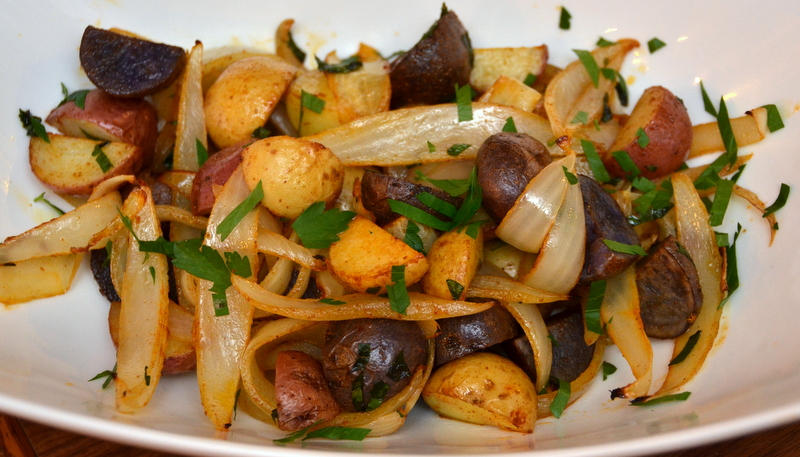Parsley and parties
/Growing up in Louisiana, I attended lots of parties. Not just formal affairs for Mardi Gras or Christmas but also neighborhood soirees and cocktail parties hosted by my parents' friends. I loved all these fetes, loved dressing up and seeing people, assessing the spreads and noshing on my favorite dishes. Perhaps it's fairly obvious that I still take great pleasure in parties and really love all their festive concomitants; I truly enjoy hosting, derive much joy in cooking for others, appreciate great food and drink, love setting a pretty table. Mom and I used to give the "refreshments," as I liked to call them, a full overview before committing to a first plate. Always -oddly?- I loved the inevitable parsley garnishes tucked around the tenderloin or salmon, nestled by the crudités or bowl of dip. Fortunately, few others seemed to give these bright green sprigs much thought and so neither noticed nor minded the girl swiping bouquets of them and then chewing with satisfaction.
The parsley was always your standard curly parsley, small parcels trimmed from the larger bunch, rather like a cauliflower broken down into florets for easier handling and eating. I didn't discover flat-leaf, or Italian, parsley until after college, when I became a cook of my own and the sort of one who cared deeply about herbal variations and the implications therein. Though I now use flat-leaf parsley almost exclusively, the curly remains unbeatable if you're looking to enjoy the simple satisfaction of noshing on an unadulterated green.
I started musing about my history with parsley when a friend recently asked if I'd post a "tutorial" about the various types of parsley and just what can be done with them. Perhaps this primer is more than she bargained for, but it's been an awfully nice trip down memory lane. For now, let's jump in to the question at hand.
Petroselinum crispum, otherwise known as parsley, originated in the central Mediterranean -southeast Europe and far west Asia- and remains an important herb in the culinary traditions of that area. Consider the role parsley plays in tabbouleh, for example, or in a bouquet garni. How many plates of risotto and pasta garnished with chopped parsley have you enjoyed? The always-pleasing gremolata is a parsley-centric accompaniment to many a dish, and parsley plays a weighty role in most versions of chimichurri (or salsa verde as the Italian iteration is known). It's a humble but significant herb, one that pretty much anyone with a pot, soil and sunshine can grow and enjoy.
Curly parsley is most commonly used as a garnish, hence my early experiences with it as just that. Its leaves are smaller than its flat-leaf brethren and some believe its taste is less pronounced. I myself think that the tongue's experience with such crisply ruffled leaves affects our ability to as clearly discern its taste. Flat-leaf parsley sometimes has thicker stems and can have a slightly woodier taste, as heftier trunks might suggest. I use flat-leaf more because it has a clean, clear flavor not entangled with any texture.
Parsley rarely offends; I mean seriously, when was the last time you thought the main problem with any dish was the parsley in it? Probably never. It's pretty and adds a lovely yet fairly muted fresh flavor to many things. As Harold McGee says, it's relatively "generic," really and can "therefore complement many foods."
The best way to store a fresh bunch of parsley is in a small cup of water on a windowsill, as if it's a bouquet of flowers. When I purchase some parse (my shorthand), I come home, untether it from its twistie binds, maybe (serious maybe because I tend to be lazy) trim any ends that look splayed or old or soft, fill a juice cup with water and stand the bunch up in it. I learned this trick from a cook I once knew and it really is foolproof- you'll get days from your parsley that you never knew it had!
This one is on my sill now. Parsley drinks water like a horse that's found an oasis in a desert, so you'll need to be vigilant about refilling its reservoir. Now that I really study this picture, I see that my guy is in need of a tall drink. Momentarily...
Parsley is good for you! It's full of folic acid, flavonoids, vitamins K/C/A and antioxidants. Unfortunately, the myth that parsley can remedy bad breath seems to have been proven false, but that doesn't stop me from trying to make Percy eat it as often as possible. It can't hurt!
Especially when someone else starts it for you, parsley is easy to grow provided you have a spot where the sun shines assertively and you're willing to water. Certain animals, such as the goldfinch and a few butterflies, really groove on parsley or its seeds, so that's cool too. And I have had great luck with parsley reseeding itself and acting as quite the perennial in my little garden.
Let me bring this to a close by providing a few ways to use parsley now.
Snip it over anything and everything as a garnish. Just look at part of my dinner tonight: pimentón-roasted potatoes and onions with parsley both before and after.
Spaghetti alle vongole? LOVES a parsley garnish! NEEDS it! Tabbouleh! Parsley is critically important; Ina Garten's recipe calls for a full cup. What about my roasted sweet potatoes with hazelnut gremolata?
I find myself snipping away at my parsley bouquet all the time. Bet you will too!




